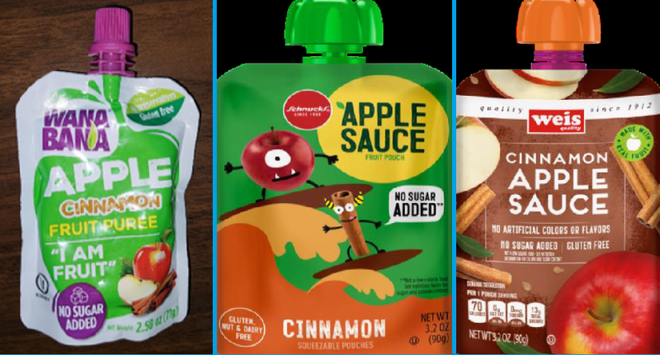Cinnamon in recalled applesauce pouches may have had 2,000 times the proposed limit of lead
The U.S. Food and Drug Administration says its investigation of lead-contaminated cinnamon-flavored applesauce pouches has found that some samples had as much as 2,000 times the highest-recommended amount of lead allowed, the latest development in a recall that has sickened dozens across the U.S.
The finding comes from the FDA's inspection of the Austrofoods facility in Ecuador, where the recalled products – WanaBana apple cinnamon fruit puree pouches, Schnucks cinnamon-flavored applesauce pouches and variety packs, and Weis cinnamon applesauce pouches – were produced, the agency said in an update Monday.
Analyzed samples of cinnamon supplied to Austrofoods by Ecuador-based Negasmart were found to have lead levels of 2,270 parts per million (ppm) and 5,110 ppm, the FDA said. In comparison, the Codex Alimentarius, a commission established by the World Health Organization and the United Nations, is considering adopting in 2024 a maximum of 2.5 ppm for lead in bark spices including cinnamon, the FDA says. That places the Negasmart samples at 900 to 2,000 times the commission's proposed maximum level of allowable lead in food.
But there's no safe level of lead in children's blood, according to the FDA and the Centers for Disease Control and Prevention. "No level of lead is good for you," food safety lawyer Bill Marler told USA TODAY. "It's obviously concerning. … Anybody who's eaten this should be tested for blood levels."
The CDC recommends calling your health care provider to get a blood test if you or your child may have eaten the recalled products.
Quaker Oats recall:Food maker recalls some of its granola bars, cereals for possible salmonella risk
Number of those affected in the applesauce pouches product recall grows
The FDA on Tuesday increased to 69 the number of cases of illnesses potentially linked to the products; 28 states have reported cases and all impacted have been under 6 years old. But the CDC has received 205 reports of cases in 33 states – up from 125 in 22 states last week – in its tracking of the cinnamon applesauce lead poisoning outbreak. Of those cases:
- 67 are confirmed
- 122 are probable
- 16 cases are suspect.
To be included in the CDC numbers, the person must have high blood levels within three months of eating one of the products after November 2022. (The CDC and FDA can have different case numbers because they gather data differently.)
How did recalled applesauce pouches get contaminated with lead? FDA investigating potential food fraud
In its ongoing investigation, the FDA is exploring "the potential that the cinnamon contamination occurred as a possible result of economically motivated adulteration," or EMA, the agency said in a statement to USA TODAY.
An example of EMA could involve food makers intentionally substituting an ingredient "to make it appear better or of greater value," according to the FDA. But the agency also says that such actions may be food fraud and result in "lead poisoning from adulterated spices and allergic reactions to a hidden, substituted ingredient that contains even just one food allergen."
In Bangladesh, lead chromate has been added to turmeric, for example, as a way to enhance the color, according to Unicef. That's only one source of lead that's resulted in 35 million children in Bangladesh having elevated blood lead levels, the organization says. Another source: the illegal recycling of used lead acid batteries near homes.
But in the U.S., an intentional food product contamination is highly unusual, Marler said, citing a 2009 case involving Peanut Corporation of America's intentional lying about salmonella in its products. The resulting outbreak sickened 714 and was one of the largest food recalls in U.S. history.
"I've been doing this for 30 years and I can count on one finger how many intentional contamination events occur," said Marler, who is also publisher of Food Safety News.
With ever-growing food production supply chains including suppliers from outside the U.S., "the FDA doesn't have the people power to do the kind of oversight we sort of expect they would," he said.

How did officials identify the lead problem in applesauce pouches?
An investigation by the North Carolina Department of Health and Human Services and the North Carolina Department of Agriculture and Consumer Services found four children with elevated lead levels in their blood, which indicated potential acute lead toxicity.
These tests are done as part of CDC funding to states, notes Helena Bottemiller Evich, founder and editor-in-chief of Food Fix. "Cinnamon has a track record of lead contamination – whether from soil uptake into the plant, environmental exposure or even other things getting mixed in with ground cinnamon – but the levels here would likely be off the charts compared to what is typically found," she wrote in November, after the recall was expanded.
The FDA issued a public health alert on Oct. 28 advising against consuming or buying WanaBana apple cinnamon fruit puree pouches because they may contain elevated levels of lead. Subsequently, the agency added Schnuck brand and Weis brand products to the recall.
"I think the public and the FDA got lucky in having this testing being done randomly on kids, or we never would have known about it," Marler said.
Since elevated levels of lead in the blood can affect individuals differently, "the issue is really going to be what kind of monitoring is going to have to be needed for the kids who consumed this product," he said.
Follow Mike Snider on X and Threads: @mikesnider & mikegsnider.
What's everyone talking about? Sign up for our trending newsletter to get the latest news of the day
Disclaimer: The copyright of this article belongs to the original author. Reposting this article is solely for the purpose of information dissemination and does not constitute any investment advice. If there is any infringement, please contact us immediately. We will make corrections or deletions as necessary. Thank you.







